Rhinos were violently demised from Uganda during Idi Amin’s brute regime and the following chaotic years. Nevertheless, it’s still possible to spot these gray giants grazing among the vast savannah. Ziwa Rhino Sanctuary has championed to re-introduce the extinct southern white rhino back to Uganda. Heated with the tragic history, fear, and excitement, we followed a ranger on foot to track down our first white rhinos.
“Can you climb trees?” our ranger asked for starters. I nodded laughing, yet a bit uncertain whether he was bantering. “White rhinos are not aggressive by nature. But if they feel threatened, they can attack”, he emphasized gravely and continued, “Make sure not to run when a rhino is approaching. If you cannot run faster than 45 km/h, the rhino will win.” Then the ranger smiled widely and started to pour his love for rhinos on us. Soon the excitement became too much to handle, and we hopped in a jeep to track down the nearest rhino.
Getting into the Spirit of Ziwa Rhino Sanctuary
We had arrived at Ziwa Rhino Sanctuary the day before, not sure what to expect. After driving through the pitch-black savannah all the way from Kampala, we were cheerfully received as the only guests. An armed guard escorted us to an open-air restaurant since a rhino was hanging out near our cabin and it wasn’t yet safe to go there. A couple of dimly lit lanterns and a thick curtain of insects separated us from the wild while we dined in the dark. In the next morning, we woke up to the chirping of exotic birds. Peeking through the window made it clear: the place looked like a sanctuary, too.
Ziwa Rhino Sanctuary is the only place in Uganda where rhinos live in their natural habitat. Under 24/7 surveillance of armed guards, totally 16 southern white rhinos are munching their way through 70 square meters’ private land, separated from the surrounding bush with a 2-meter electric fence. The southern white rhinoceros is the most widespread rhino species, yet it was nearly extinct already in the early 20th century, with only 20 individuals living in one South African Reserve. By 1982 savage poaching had wiped out both black and white rhinos from Uganda.
Tracking Rhinos on Foot
Heavy-hearted thoughts escorted our jeep through the grassy mud paths until we suddenly stopped beside a pile of rhino poo. These magnificent creatures made an instant good impression on us as they always use the same spot as their toilet. This was the first trace of nearby rhinos, meaning farewell to our jeep.
Next, the ranger pointed out fresh footprints and a proper kind of bush where rhinos could hide from direct sunlight. Off we rambled through scrubland, trying to find more tracks ourselves. Just when we were starting to feel like ancient hunter-gatherers, the bushes revealed a fellow ranger grinning at us, holding a radio phone in his hand. Of course, our ranger knew exactly where the rhinos were because they have around-the-clock guards.
A slight letdown was soon forgotten when our ranger whispered that we could slowly walk towards two rhinos that were still hiding from our sight. “For your own safety, you must follow the tracking rules and my commands at all times. Rhinos are wild animals, and although this is their breeding area, they are kept here as wild animals,” he reminded us.
Observing the Rhinos in Their Natural Habitat
The first glance of the wrinkled-skinned giants felt surreal, although some leafy branches were covering most of our field of view. The rhinos were still about 50 meters from us, behind verdant bushes. Morning sun speckled the ground around us; there was something serene in that very moment. We had seen black rhinos in Tanzania, but it was completely different to observe them from the comfort of a jeep. Now we were in the wilderness with the rhinos, with only two rangers as our protection. If the rhinos would have chosen to harm us, they could have easily done so. But they were just swinging their heads back and forth upon the grass, not minding about our presence.
We were photobombing the rhinos desperately, most of the time against the sun and from too far a distance for our lenses, because we thought that this was it. The ranger waited patiently, secretly laughing I bet, before telling that we could proceed closer. Waiting for the permission to move, we followed his steps cautiously. For around half an hour, we circled the rhinos, watching them spellbound – from different angles, near and further, through bushes and without any privacy screen. Occasionally we were just 10 meters from them. I still couldn’t believe that we were walking with the rhinos!
The rhinos were doing what the rhinos do: mostly eating. An adult Southern white rhino weights about 2-3 tons and eats 150 kilograms of grass each day. The massive need of food means that the rhinos spend most of their waking time eating. They don’t have time to sleep during the night, either. Only the scorching heat forces them to recede for a beauty nap in the shade of the bushes.
While monitoring the rhinos, the ranger kept us well informed about their habits and characteristics. We were observing a 15-year old female called Bella and her 1-year old calf, Luna. Bella belongs to the first group of rhinos that Uganda received after the extinction, donated by EU. At the time of our, visit Bella was already pregnant, though the current calf was still whining for milk with funny sounds. White rhinos give birth every two or three years; the calf remains with her mother until the next baby is born.
From the distance, we couldn’t see how these white rhinos would differ from the black rhinos that we had seen in Tanzania. Both white and black rhinos have two horns on their snout. There’s no actual color difference either; instead, you can identify the subspecies by looking at their mouth. In fact, “white” originates from a misspelling of “wide” that refers to the wide lip of the white rhino. Black rhinos have smaller, hooked lips, which allow them to grab tree branches. The head of the white rhino is so heavy that it can’t lift it to eat from the trees, but the wide mouth eases grazing. Thus the formal name square-lipped rhinoceros would be both correct and descriptive appellation to white rhino.
An hour flew by quickly – maybe because we felt so thrilled, or because the company was so entertaining. After the well-spent quality time with the white rhinos, our jocular ranger asked, if we knew where our jeep was. It was a quick reminder of how easily you get disoriented in the bush. Luckily he was kind enough to escort us back, though.
“New White Hope” Heals the Tragic History of Ugandan Rhinos
Uganda was once the only East African country with the both African rhino species: black and white. Whereas rhinos were hunted already during the British colonial era, Idi Amin’s fierce regime led the way to their complete extinction in 1983. When Idi Amin came to power in 1971, Uganda had still 300 black and 100 white rhinos. Three years after his overthrow, both species had died out.
After the extinction, six white rhinos were brought back to Uganda during 2005 and 2006, in the hope of creating a new generation. Of course, the rhinos weren’t roaming freely around the national parks, but well guarded inside the boundaries of Ziwa Rhino Sanctuary. After four years of nurturing, the first calf was born. Heart-breakingly, it was a stillborn. The next year brought finally a healthy baby, the very first rhinoceros born in Uganda in almost 30 years. That calf was aptly named Obama, since its mother hails from the States and father from Kenya. Thanks to felicitous mating, the Ziwa Rhino Sanctuary just celebrated its tenth baby rhino. All the females are also happily pregnant, so there should be more baby showers on the way.
Ziwa Rhino Sanctuary endeavors to reintroduce rhinos into Uganda’s National Parks. It’s an ambitious goal, requiring both successful breeding and the support of locals. Poaching is still the worst enemy of their work. Changing mindsets might be even harder than giving the rhinos round the clock protection. However, through education and community uplifting projects Ziwa Rhino Sanctuary is already on its way to winning the hearts of the surrounding communities.
Visiting Ziwa Rhino Sanctuary
Ziwa Rhino Sanctuary lies in Nakasongola district, about 180 kilometers north from Kampala. If you’d like to track the rhinos, the best timing is either early morning or late afternoon. When it’s hot, rhinos prefer to hide in the bushes. Reserve at least 2 hours for the tracking activity and some extra time for hanging around in the sanctuary. To get there you should have your own wheels, which are also well needed to get near the rhinos in the 7000 ha sanctuary. A car with a driver can also be rented from Rhino Uganda Fund. The Rhino tracking costs 40$ per person and vehicle rental 25$ per group.
Support the Ugandan Rhinos
The most entertaining way to support Ugandan rhinos is to visit Ziwa Rhino Sanctuary and make a donation on the spot. Protecting the rhinos 24/7 requires 80 well-trained guards and rangers, for example. The annual costs of Ziwa Rhino Sanctuary are around 500 000 $.
Rhino Fund Uganda is an NGO relying mainly on donations and sponsors. They are in a desperate need of new vehicles and equipment. The rhinos tend to thank for their protection by tossing around the guards’ bikes: we saw concrete evidence of this practice. If you’d like to support the rhino conservation in Uganda, go rhino tracking in Ziwa Rhino Sanctuary or please consider an online donation for Rhino Fund Uganda.
*Disclaimer: Our safari and rhino tracking in Uganda was hosted by Mamaland Safaris, but all the opinions and views expressed here are totally our own.
Pin this story!
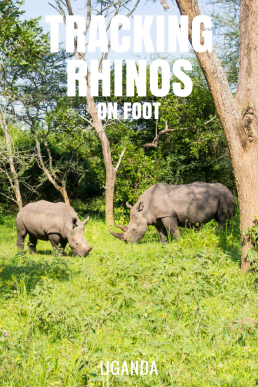
You May Also Like to Read:
The Mighty Murchison Falls and its National Park in Uganda
Murchison Falls National Park has versatile biodiversity and many animals. Cruise on the Nile river and visit its great, namesake falls.
Gorilla Tracking in Bwindi Impenetrable Forest, Uganda [VIDEO]
A video about an extraordinary adventure - gorilla tracking in Bwindi Impenetrable Forest National Park in Uganda.
Chasing Lions at Queen Elizabeth National Park in Uganda
Track tree-climbing lions, take a boat safari in Kazinga Channel or visit bat cave in the beautiful Queen Elizabeth National Park in Uganda.
Looking For the Big 5 – It’s a Game
On a safari adventure looking for the famous Big 5 in the Northern Circuit of Tanzania. It’s an amazing and surprising Game.


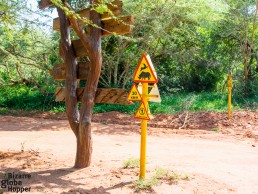
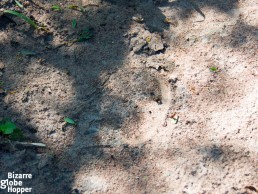
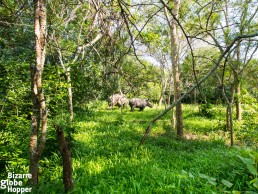
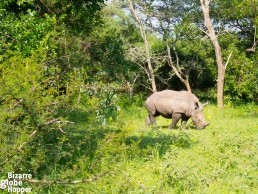
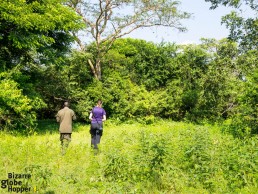
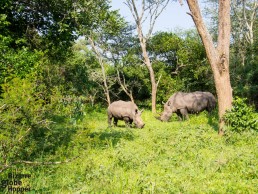
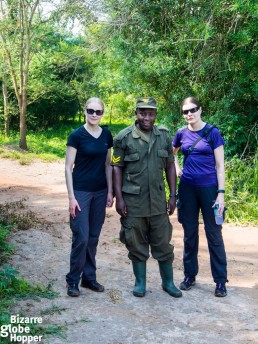
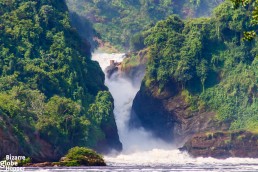
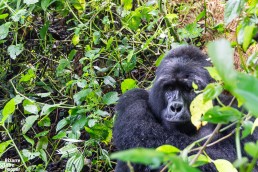
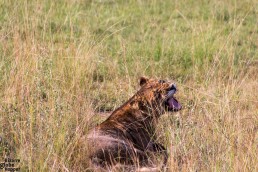
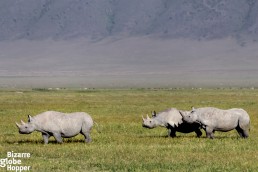
Great article! Hopefully their reintegration project works well. Thanks for sharing 🙂
I agree, you just have to appreciate all the guards, scouts, and rangers out there! Looking forward to your posts around Africa!
We did it and loved it! it was great to see the guards who spent their life’s protecting the rhinos.